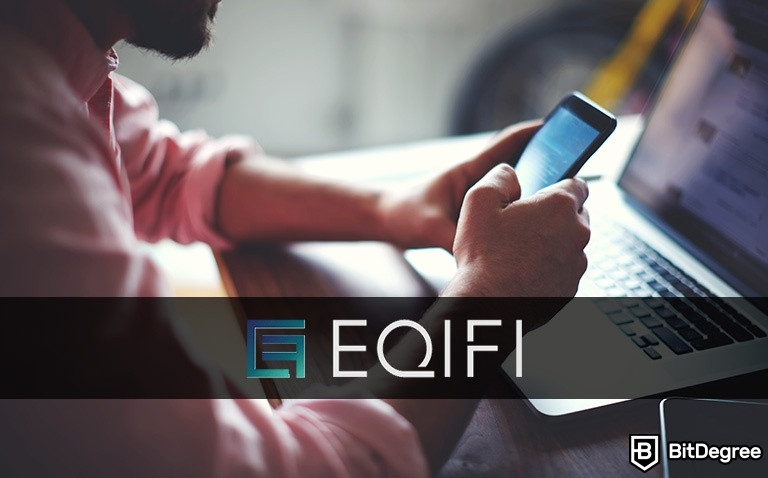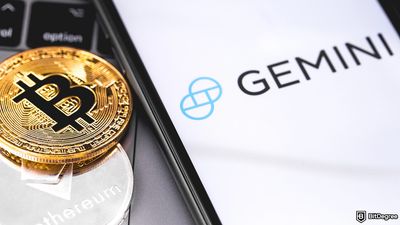In our EQIFi review, we’ve discussed all of the most-notable features and benefits that you might expect to encounter if you do choose to use the services of the crypto yield aggregator in question. If you’ve missed the review, make sure to check it out! In this article, however, we’ll be looking at how to use EQIFi, and all of its core features.
Now, if you HAVE read the review, you’re probably well-aware of the fact that EQIFi does offer quite a few features to its users. Here, we’ll cover all of them, from the very beginning - everything from the registration on the platform, all the way to deposits, APY, yield farming, and so on.
First of all, though, it’s worth laying down some context to the background of EQIFi - where it came from, what’s with the whole “powered by a licensed bank” ordeal, and other questions like these.

Did you know?
Want to get smarter & wealthier with crypto?
Subscribe - We publish new crypto explainer videos every week!
ICO vs IDO vs IEO: Which One's the Best? (Easily Explained)


Table of Contents
- 1. The Background of EQIFi
- 2. How to Use EQIFi: The Basics
- 2.1. How to Register on EQIFi?
- 2.2. How to Use EQIFi’s Yield Aggregator?
- 2.3. How to Stake EQIFi Tokens?
- 2.4. How to Deposit / Become a Liquidity Provider on EQIFi?
- 2.5. EQIFi Borrowing and Bridge Features
- 2.6. Interest Rate Swaps
- 3. A Note On the EQX Token
- 4. Conclusions
The Background of EQIFi
While we’ve discussed the general aspects of EQIFi in our dedicated review, it’s worth taking a deeper look at the platform's inception, and talking about its roadmap, before getting to the actual “how to use EQIFi” part.
Latest Deal Active Right Now:
$600 WELCOME BONUS
Binance Black Friday Deal
If you're new to Binance, great news - this Binance Black Friday period, you can earn up to $600 in rewards. Sign up, use the code 49316610, and start earning now!
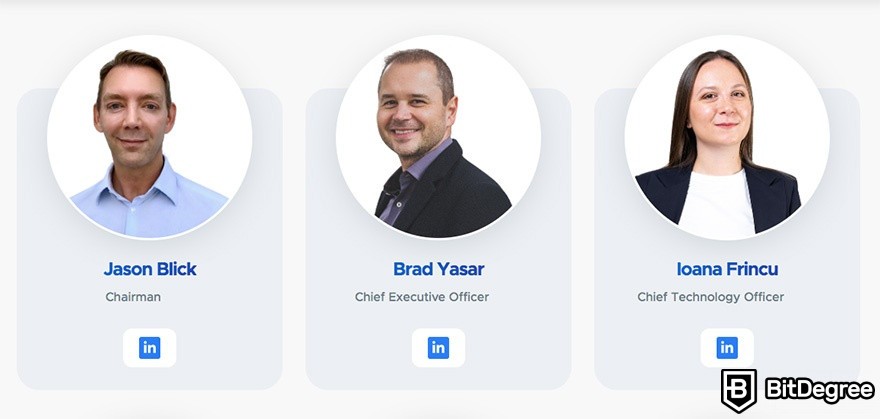
The project’s roadmap actually starts at Q4 of 2020. Beginning with feature plans and the set up of DevOps infrastructure, EQIFi quickly started shoving out features in the upcoming months - MetaMask integration, KYC processes, banking products, yield aggregation, EQIFi interest swaps, security audits, and so on.
As of the time of me writing this “how to use EQIFi” tutorial, the platform is currently working on a partnership with Bittrex Global (a well-known cryptocurrency exchange), additional banking features, and new integrations. EQIFi is also set to release its debit card very soon, as well!
With all of that being said, at the forefront of EQIFi stands another financial institution - EQIBank. This is an official, licensed and regulated bank that powers many of the EQIFi platform’s operations.
A single look at EQIFi “About” page will reveal the team behind the project in question. Among the members of the team, you will find David Cullinan - the CMO of EQIBank.
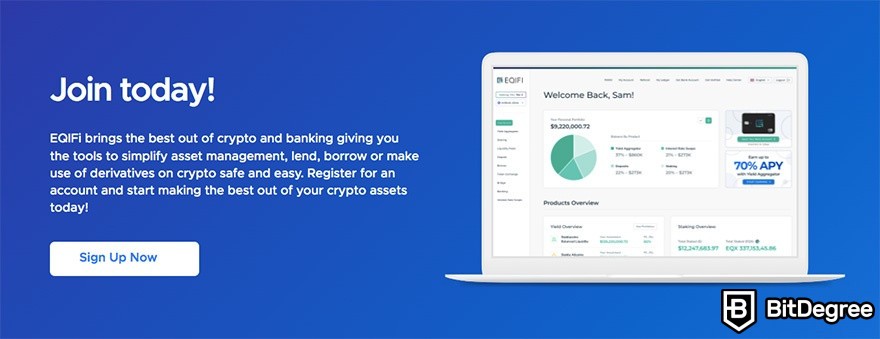
While the founders of the company appear to be Jason Blick (according to his own LinkedIn page) and Brad Yasar, the current CEO is Brad (Jason is the Chairman). The team consists of 8 people, in total (including David Cullinan), and is rather diverse.
Apart from EQIBank, the project has partnerships with multiple other financial ventures, too. Zokyo, Gate.io Labs, MoonWhale, Autonomy Capital, Glass, and many others are listed as strategic partners of EQIFi.
In addition to the team composition, the other big thing that you need to understand is the mission that the company behind the project has. The EQIFi platform aims to become the No. 1 DeFi venture in the space, offering its users a huge variety of different financial products and services - ones that relate to the decentralized finance sector, and crypto.
Why? Well, EQIFi aims to make the space simpler, safer, and more accessible to everyone. The project has laid out these goals with the belief that, while the space is full of different crypto platforms, many of them are super-complex, and have a steep learning curve that simply won't be approachable to many newcomers.
EQIFi wants to maintain a platform where you would be able to start managing your crypto, with zero prior knowledge about the space. This simplicity includes being able to access all of the more-advanced investing tools, with just a few clicks of your mouse!
So - with all of that covered and out of the way, let’s take a good, close look at how to use EQIFi, shall we?
How to Use EQIFi: The Basics
So, as mentioned earlier on in the tutorial, we’ll cover all of the core features of EQIFi, and take a look at how you could utilize them for your own benefit. To start things off, though, let’s take it from the top, and look at the registration process of the platform.
How to Register on EQIFi?
In order to start your registration, you will need to go to EQIFi’s official website.
Step 1: At the top-right corner of the homepage, click the “Sign Up” button.
Step 2: You will need to enter your legal name and surname, as well as your email address, and create a password. Do so.

Step 3: Once you confirm your email address, that’ll be it - you’re in!

A three-step registration process is pure bliss, no matter how you look at it. Once you log into your account, you will find yourself in the general dashboard - this is where you will be able to start checking EQIFi out, and using all of its services.
On your left side, you’ll find all of the available products that you can use on the EQIFi platform - we’ll get to them in a minute.
Scrolling through the page itself will showcase your account summary, prompts to pass KYC verification, and introduce you to the various features that are available on the site.
Now is probably a good time to discuss the KYC part of the platform, as well.
Being affiliated with and powered by a regulated and licensed banking institution, EQIFi is in a very unique position, identity verification-wise. While it does offer users DeFi-related services, if you want to truly unlock all of the benefits available with the project, you will need to both submit proof of your ID (Level 2), as well as an application form (Level 3).
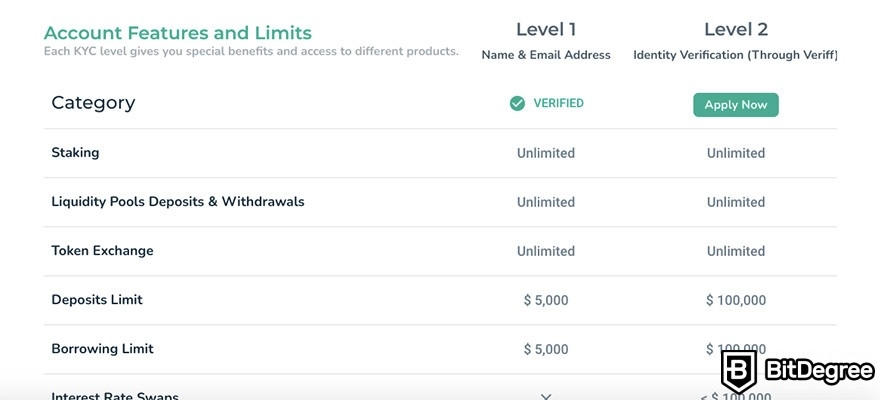
Yes, the KYC process is segmented into three different levels. Your account, by default, is Level 1, as soon as you verify (confirm) your email address. This level allows you to look around the platform, and “get a feel” for how things are.
If, however, you’d want to increase your deposit, yield farming, or borrowing limits, participate in interest rate swaps, or attach your fiat debit card to the platform, you will need to upgrade your account level.
This just goes to show that EQIFi does comply with the relevant KYC laws and regulations - in this context, that’s a good thing.
Still, though, do keep in mind that you ARE able to learn how to use EQIFi, as well as check out most of its features, without submitting any proof of your ID. That’s definitely awesome for anyone who’s still “on the edge”, and wants to experiment with the platform first, before making any long-term decisions.
How to Use EQIFi’s Yield Aggregator?
The very first feature that we should check out in our tutorial of how to use EQIFi is yield aggregation.
Just as the term might imply, it’s a product that allows you to earn passive crypto income by simply holding your assets, and making them “work for you”. You become a liquidity provider, and thus, get rewarded an APY, which ranges depending on a few different factors.
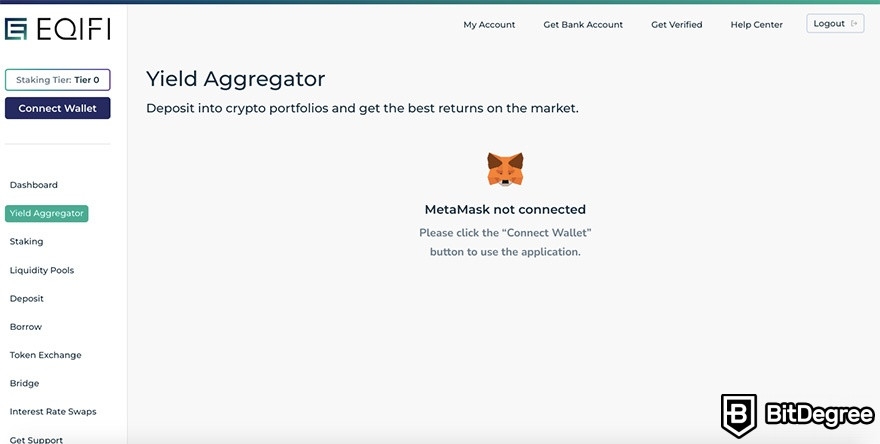
The APY available on the EQIFi yield aggregator can go up to 70% - that’s a huge number! Naturally, it does sway, and depend on various circumstances, but that’s still pretty good, nonetheless!
So, let’s take a look at how you can start utilizing EQIFi yield aggregation, shall we?
Step 1: On your dashboard, navigate to the “Yield Aggregator” section at the far-left side of the screen. Here, you will be asked to connect your MetaMask wallet to the platform - do so.

MetaMask is the most popular wallet for Ethereum. Having this wallet set up and loaded with some ETH is a mandatory requirement in order to use EQIFi deposits, its yield farming functionality, as well as other features, too. While not directly related to this tutorial on how to use EQIFi, it’s still something to keep in mind!
Step 2: Once you connect your wallet, you will then need to choose the liquidity pool that you want to add your funds into. There are three options to pick from - Stablecoins, Stablecoin & Ethereum, Ethereum. The pools provide APYs of up to 7%, 55%, and 70%, respectively.
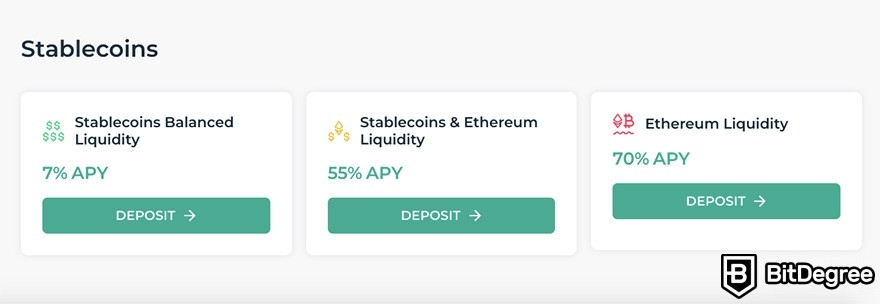
Once you choose a pool, you will be able to pick the token that you want to deposit, and start the process. However, most users that talk about how to use EQIFi don’t mention the fact that the minimum deposit in one of the yield aggregator pools is $1000 (it's equivalent in tokens).
That’s honestly a bit of a downer. It places a pretty specific bar on entry for anyone who might want to earn extra passive income via the yield aggregation feature!
If you DO have $1000 worth of tokens to spare and lock in a yield aggregation pool, you need to simply pick the token that you’d like to deposit, and then press the “Deposit” button in the EQIFi yield aggregator interface. That’s about it!
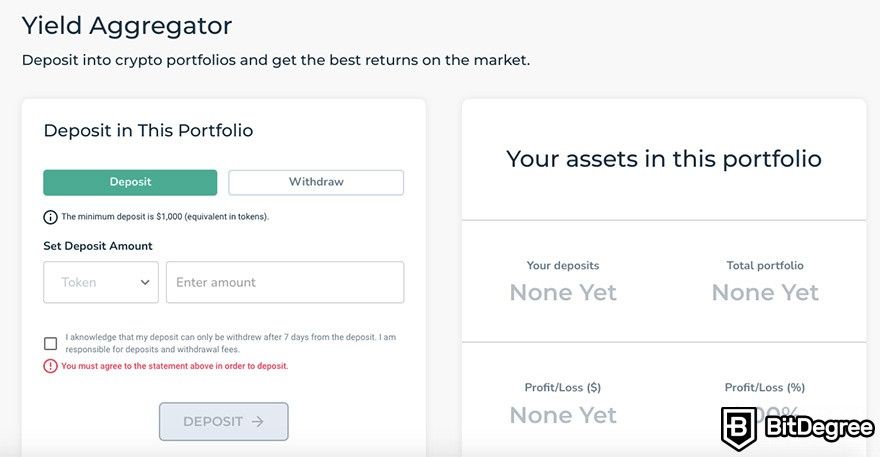
On the right side of the screen, you will be able to see your assets in the current portfolio. Scrolling a bit towards the lower part of the page, you’ll also have the chance to view the historical performance of your deposit.
All in all, same as the rest of the EQIFi platform, the yield aggregator is pretty simple to navigate and use, as long as you already know what you’re doing, and what it is that you’re trying to achieve. If you have prior experience with MetaMask, know how to buy, sell, and transfer cryptocurrencies, and understand the concept of yield farming, you should be golden!
The only major barrier of entry, however, is the $1000 minimum that you’ll need to lock in any one of the pools. Not everyone might have this amount of money to simply lock in a yield aggregator!
How to Stake EQIFi Tokens?
Next up, EQIFi deposits (of the EQX token), and the platform’s staking functionality.
In order to stake on EQIFi, you will need to hold some EQX tokens (the native token of the platform in question). The tokens may be traded on Uniswap and PancakeSwap, as well as the KuCoin and Gate.io cryptocurrency exchanges.
Staking on EQIFi consists of 4 different tiers. Each tier has a different requirement of EQX tokens (from 10,000, up to over 1 million), and thus also provides increased staking rewards (up to 20% annually), borrowing limit, LTV boosts, and so much more.
If you’d like to learn more about the benefits of holding and staking EQX tokens, you can check out my EQIFi review, where I go into the topic, in-depth.
So, how should you go about staking your tokens on EQIFi? Let’s analyze the process, step-by-step.
Step 1: As pointed out earlier in the chapter, as you learn how to use EQIFi, you will need to purchase some EQX tokens to get started. Either trade them on DEXs such as Uniswap, or on centralized platforms like Gate.io (for USDT coins).
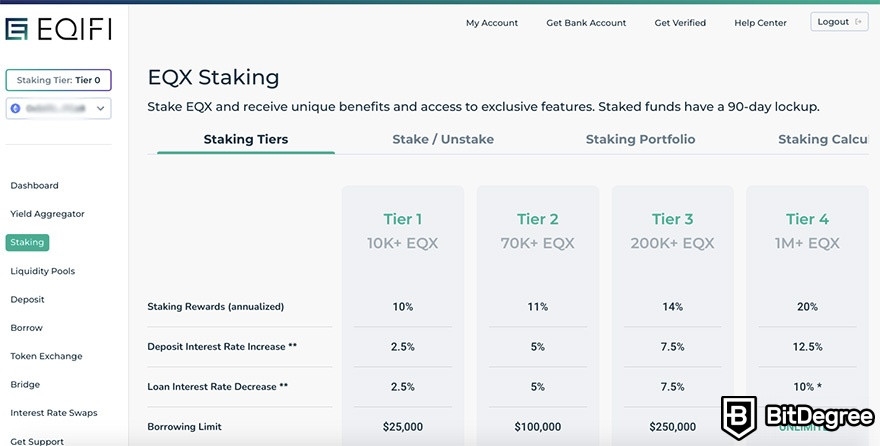
Note, however, that to start earning extra benefits while staking, you will need to have at least 10,000 EQX tokens at your disposal. As of writing this “How to Use EQIFi?” tutorial, this amount of EQX is worth almost $900.
Step 2: In the staking section of your dashboard, navigate to the “Stake/Unstake” tab. This is where you are able to enter the amount of EQX tokens that you’d like to stake, or even buy EQX, if you still don’t have these tokens.
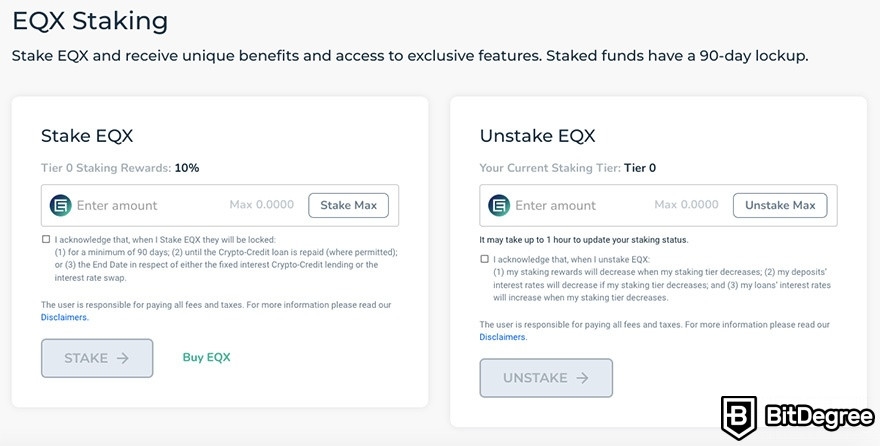
Buying EQX is also possible via the EQIFi platform, as well. Specifically, you may trade WBTC, ETH, USDT, and USDC for EQX.
Step 3: Once you have the tokens, and decide to stake them, you will be able to see your current staking information on your dashboard.
One thing to note here is that, upon confirming the stake, you won’t be able to withdraw your staked tokens for at least 90 days. The date may also be pushed even further, depending on a few additional variables (you can find all of the relevant information in the “Staking” section of the EQIFi platform).
How to Deposit / Become a Liquidity Provider on EQIFi?
Staking and EQIFi yield aggregation are some of the most popular reasons why people turn to the platform, in the first place. However, it’s worth pointing out that there are other things to learn about when it comes to the question of how to use EQIFi!
Arguably before you even start figuring out the yield aggregator tool available on the site, you could first get familiar with the deposit and liquidity provision features of the platform.
When it comes to liquidity pools, things are pretty simple. You are able to see the TVL (Total Value Locked) in EQIFi, at any point in time, as well as access a liquidity pool yourself.
In order to do so, you will simply need to navigate to the “Liquidity Pools” section of your dashboard, and then press “EQX-ETH (Uniswap)” under the “Provide liquidity” section.

You’ll be able to deposit a select amount of ETH or EQX tokens, and start earning a passive interest. Another way to approach this (something that needs to be done before you can even start providing liquidity, that is) is with EQIFi deposits.
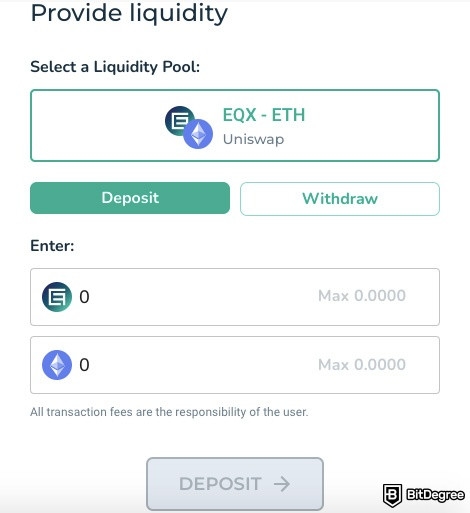
Deposits can be made in four cryptocurrencies - WETH, WBTC, USDT, and EQX. With variable-rate deposits, there is one exception - WETH can’t be used.
In order to make a deposit, you first need to navigate to the “Deposit” section of your dashboard. Here, you will be able to see your current stats on the left side, as well as make a new deposit on the right-side interface.
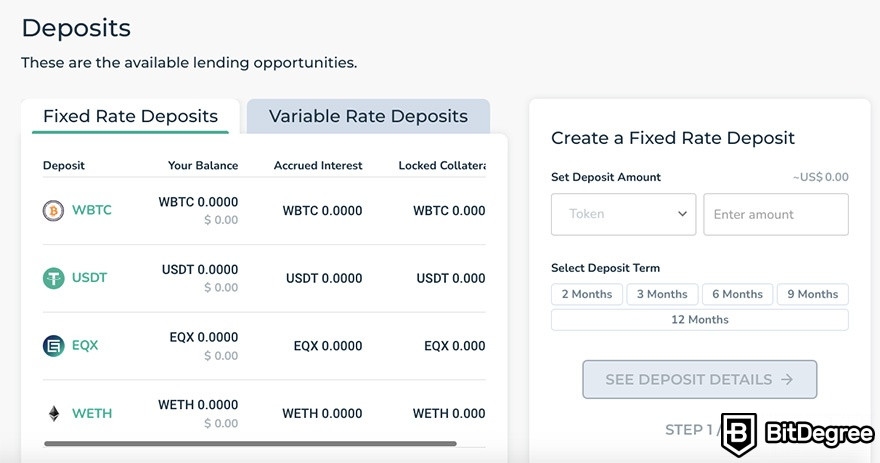
Simply select the token that you want to deposit, enter the amount, and select the term. Upon confirmation, your funds will be deposited into EQIFi.
Withdrawing them is very simple, as well. You just need to pick which deposit you want to withdraw from, and click a single button - that’s it!

Did you know?
Want to get smarter & wealthier with crypto?
Subscribe - We publish new crypto explainer videos every week!
What is a Smart Contract? (Explained with Animations)


EQIFi Borrowing and Bridge Features
Apart from the EQIFi price predictions and yield aggregation, another very popular search topic for individuals interested in the platform is the borrowing feature.
It makes perfect sense, too - the fact that you can borrow money (in the form of crypto assets) is one of the core features of the EQIFi platform. It’s also something that many people who are looking at how to use EQIFi want to learn, too.
That said, let’s not waste any time, and get right to it.
Step 1: The very first thing that you’ll need to do is create a deposit. We’ve covered this point in the previous subchapter of the guide, so do refer to that if you’d like to learn more about this point!
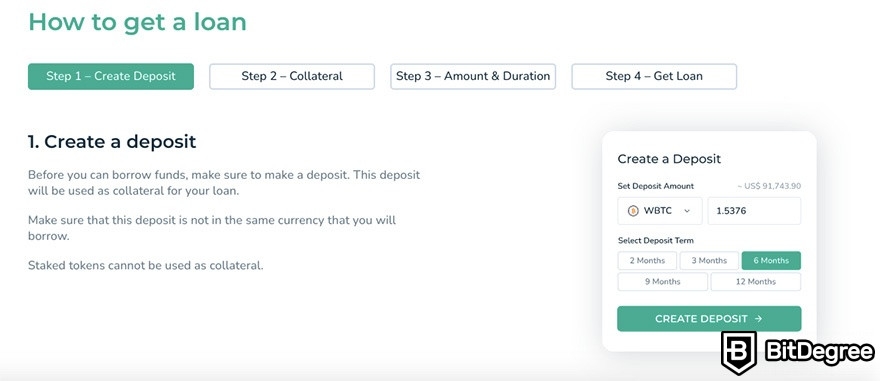
Note that your deposit can’t be made in the same cryptocurrency as you will want to borrow. This is because this deposit will be used as collateral for your loan.
Step 2: Now, you need to set your collateral, as well as the token of the loan itself. The process (on EQIFi’s side of the deal) will be slightly different for those who are looking to take out a variable-rate loan, but the general premise will remain the same.
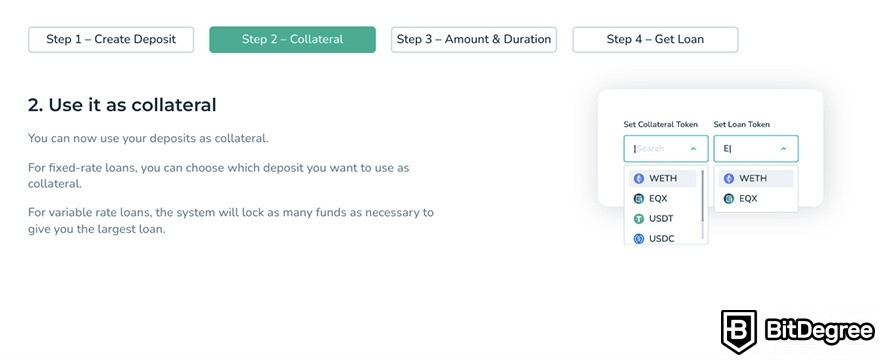
Step 3: Now, this is where things become a bit split, in terms of those taking out fixed-rate loans, and others who choose the variable-rate option. For fixed-rate loans, you will be able to set a duration for when the loan will be repaid. Variable-rate loan takers won’t have this option - instead, you will be able to repay the loan on your own terms.
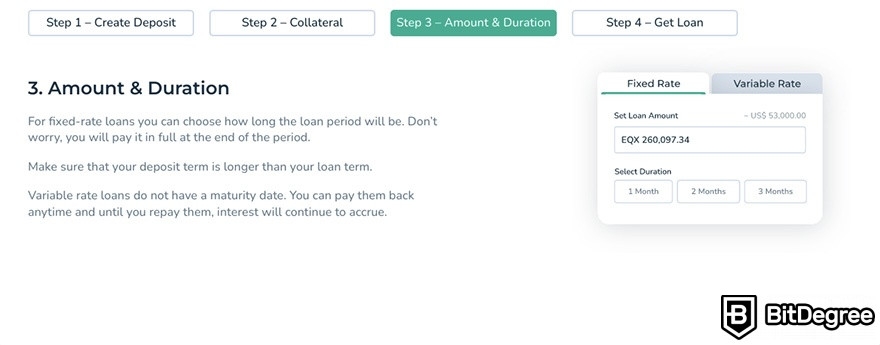
Note, though, that interest will accumulate as time goes on, until the loan is completely repaid. Thus, even though you yourself decide when to repay the actual loan, it’s important not to stall, because you might end up liquidating your collateral.
Step 4: Once all of the details have been set, that’s about it - you will sign the contract via your MetaMask wallet, and will then receive the funds into that same wallet!
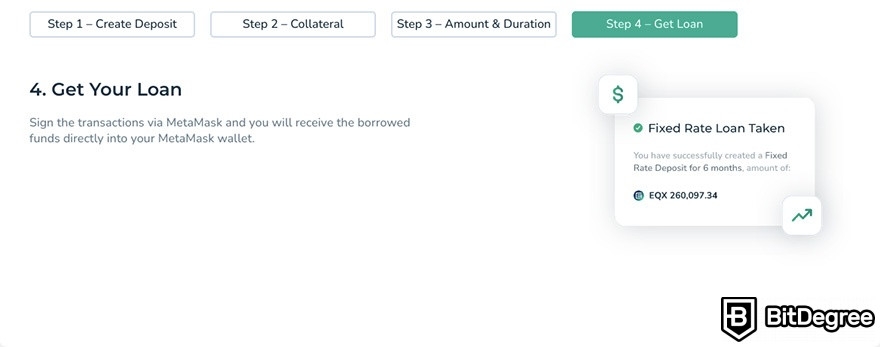
Just to quickly sum it up, the process looks a little something like this: you make an EQIFi deposit, set the collateral, choose your type of loan, and confirm the deal via MetaMask. It’s pretty simple, if you’re already familiar with how crypto lending and borrowing works.

Before we get to the EQIFi interest rate swaps, let’s take a glance at the token bridge functionality offered by the platform. While not being as well known as its other features, this is still rather notable! EQIFi allows you to bridge the gap between the Ethereum Network and the Binance Smart Chain, and exchange your EQX tokens to ones that’d be located on either one of those two networks.
In other words, you can trade your ETH-based EQX for Binance Smart Chain-based ones, and vice versa.

- A very well-known crypto exchange platform
- More than 500 different cryptos available
- Two-factor authentication
- Over 500 different cryptocurrencies available
- Strong security
- Small withdrawal fees

- Very low trading fees
- Exceptional functionality
- Mobile trading app
- Very competitive trading fees
- An intuitive mobile app
- Up to 100x leverage available

- Secure and reliable
- Low fees
- A good amount of fiat currencies accepted
- Reputable exchange
- Multiple fiat currencies are accepted
- Relatively low trading fees
Interest Rate Swaps
Last but oh-so-definitely not least, let’s also talk about the EQIFi interest swaps. We’ve discussed the interest rate swaps in detail in the dedicated EQIFi review - however, the concept itself isn’t all that simple to wrap your head around, so it’s worth a second look.
Frankly, interest rate swaps allow you to switch the settings of your loan. You could go from a fixed-rate loan to a variable-rate one, and the other way around.

There are multiple reasons why people would want to switch their loan terms - that’s not something worth focusing on. Instead, what’s worth acknowledging is the fact that the EQIFi interest swaps are a super-unique feature, in the first place!
In order to perform an interest rate swap, you will need to have taken out a loan. For the sake of this example, let’s assume that you’ve already done so.
Now, you should navigate to the “Interest Rate Swaps” section of the EQIFi platform. The swaps are segmented into two sections - Compound deposits, and active swaps.

If you’ve finished the KYC verification process on your account, you’ll be able to see the settings of your loans and deposits. In order to switch your interest rate model, there will have to be another person who wants to switch their rate, as well. Put simply, you will swap your model with that other person.
The entire process is performed with the help of a smart contract. It matches you with that other individual, and swaps your interest rate models. Furthermore, the calculations on your new interest will also be made in an automated manner, by the smart contract.
It sounds convoluted, if you’re a newcomer to the industry. However, the process is as simplified as possible, and EQIFi goes the extra mile in order to help users navigate through the entire interest rate swap as smoothly and seamlessly as possible.
A Note On the EQX Token
With all of the core features of EQIFi discussed and out of the way, there’s one more point that we need to touch upon.
Ever since the EQIFi IDO happened, holders of the EQX token have been searching for EQIFi price predictions. That makes sense, since this happens with most cryptocurrencies on the market.
The point that I’d like to emphasize here is simple - no one really knows where the EQX token price will go! It saw huge and sporadic growth in the beginning, then experienced some price-related hardships, and is currently on the rise, once again.
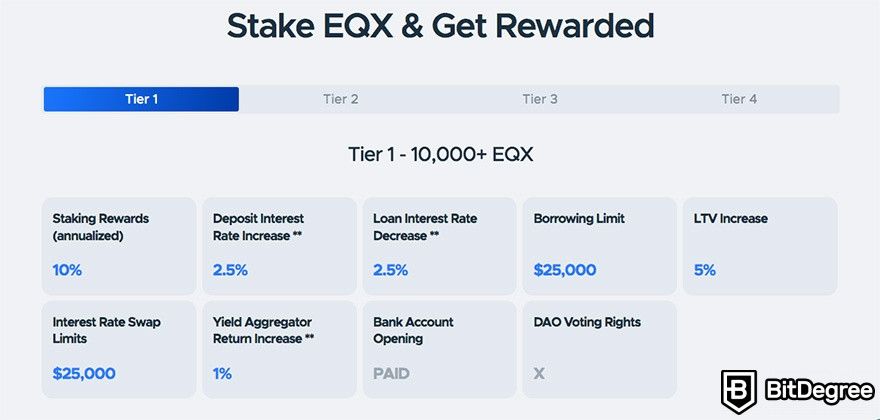
The price of this token is directly tied to two things - how much faith people put in the EQIFi project, as a whole, and the general sentiments of the market.
EQX tokens have a huge utility factor, when it comes to the EQIFi platform - everything from governance, all the way to staking, APY, and other bonuses. This, in turn, should theoretically allow them to hold their value, to an extent.
However, the market nowadays is very unpredictable. Searching for “reliable” EQIFi price predictions simply isn’t viable - instead, you should focus on the actual features available on the platform, and not the current worth of the token!
Conclusions
If there’s one big thing that you should take away from this “How to Use EQIFi?” tutorial, it’s the fact that the platform in question is full of various awesome features. With a goal to become the leading project in the DeFi space, EQIFi is doing a pretty good job!
No matter if you’re looking to borrow crypto assets, stake, or earn an APY, EQIFi will provide you with multiple different ways of going about these processes, and more - interest rate swaps, Compound deposits, EQX governance token, and so on!
The fact that EQIFi is also powered by a licensed, regulated bank only adds to the already-extensive list of benefits. That being said, the one big con that you should be aware of is the fact that, in order to use any of the core services of the platform, you’ll need to dedicate at least $900-$1000. For many individuals, this is a significant sum of money!
Also, I do have to point this out, though - keep in mind that, as with any other DeFi project out there, EQIFi should be approached with caution. Only invest money that you’re comfortable with losing, and do your own, extensive research before using the services offered by the brand!
All of that being said, thanks for reading my tutorials on how to use EQIFi! I hope that you’ve learned a lot, and that you’re now much more familiar with all of the different services that EQIFi has to offer!
The content published on this website is not aimed to give any kind of financial, investment, trading, or any other form of advice. BitDegree.org does not endorse or suggest you to buy, sell or hold any kind of cryptocurrency. Before making financial investment decisions, do consult your financial advisor.

